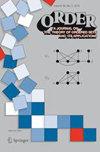$$\mathfrak {m}$$-Baer和$$\mathfrak {m}$$ -Rickart格
IF 0.3
4区 数学
Q3 MATHEMATICS
Order-A Journal on the Theory of Ordered Sets and Its Applications
Pub Date : 2023-11-06
DOI:10.1007/s11083-023-09651-9
引用次数: 0
摘要
摘要本文介绍了ricart格和Baer格及其对偶的概念。我们证明了ricart和Baer模块的部分理论可以用格理论中的技术来理解。因为,我们使用了T. Albu和M. Iosif引入的线性态射。为了给出一个更一般的方法并将我们的结果应用于模的理论,我们重点研究了一个格的所有线性自同态的模$$\mathcal {L}$$ L的一个0 $$\mathfrak {m}$$ m的子模。我们还证明了$$\mathfrak {m}$$ m -Rickart和$$\mathfrak {m}$$ m -Baer晶格可以用$$\mathfrak {m}$$ m中由模的幂等产生的湮灭子来表征。本文章由计算机程序翻译,如有差异,请以英文原文为准。
$$\mathfrak {m}$$-Baer and $$\mathfrak {m}$$-Rickart Lattices
Abstract In this paper we introduce the notions of Rickart and Baer lattices and their duals. We show that part of the theory of Rickart and Baer modules can be understood just using techniques from the theory of lattices. For, we use linear morphisms introduced by T. Albu and M. Iosif. We focus on a submonoid with zero $$\mathfrak {m}$$ m of the monoid of all linear endomorphism of a lattice $$\mathcal {L}$$ L in order to give a more general approach and apply our results in the theory of modules. We also show that $$\mathfrak {m}$$ m -Rickart and $$\mathfrak {m}$$ m -Baer lattices can be characterized by the annihilators in $$\mathfrak {m}$$ m generated by idempotents as in the case of modules.
求助全文
通过发布文献求助,成功后即可免费获取论文全文。
去求助
来源期刊
CiteScore
1.10
自引率
25.00%
发文量
27
审稿时长
>12 weeks
期刊介绍:
Order presents the most original and innovative research on ordered structures and the use of order-theoretic methods in graph theory and combinatorics, lattice theory and algebra, set theory and relational structures, and the theory of computing. In each of these categories, we seek submissions that make significant use of orderings to study mathematical structures and processes. The interplay of order and combinatorics is of particular interest, as are the application of order-theoretic tools to algorithms in discrete mathematics and computing. Articles on both finite and infinite order theory are welcome.
The scope of Order is further defined by the collective interests and expertise of the editorial board, which are described on these pages. Submitting authors are asked to identify a board member, or members, whose interests best match the topic of their work, as this helps to ensure an efficient and authoritative review.

 求助内容:
求助内容: 应助结果提醒方式:
应助结果提醒方式:


